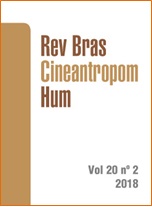Influence of hand paddles and fins on blood lactate, heart rate and perceived exertion behavior
DOI:
https://doi.org/10.1590/1980-0037.2018v20n2p155Abstract
One of the great challenges for swim coaches is proper control of the training intensity. This issue is more complex when using equipment such as paddles and fins. Among intensity control parameters, blood lactate concentration is the standard for monitoring metabolic responses, and heart rate and perceived effort are practical and inexpensive methods. The aim of this study was to compare blood lactate concentration ([LA]), heart rate (HR) and rate of perceived exertion (RPE) in swimming training series without equipment and with paddles and fins. We evaluated 11 swimmers on three different days during sessions in a series of 12 repetitions of 50 m in front crawl. The first session was performed without equipment, maintaining perception exertion at 15 (15 points) of the 6-20 point Borg scale. In the second and third sessions, athletes should swim in the series with: (i) paddles and (ii) fins, at the same swimming speed of the series without equipment, in random order. [LA], HR and RPE at rest (after warm-up and before swimming series) and after the sixth and 12th repetitions were measured and compared. The mean speed for all series was 1.30 ± 0.13 m.s-1; fins and paddles presented lower final [LA] (respectively, 5.9 ± 0.3 and 8.1 ± 0.4 mmol.l-1) and HR values (respectively, 161.1 ± 15, 5 161.1 and 170.3 ± 13.3 170.3 bpm) in comparison to series without equipment (respectively, 10.8 ± 0.7 mmol.l-1 and 178.2 ± 4.3 bpm). Fins had lower final RPE values (12.5 ± 0.6 points) in relation to series without equipment (15.8 ± 0.2 points) and similar values in relation to swimming with paddles. Swimming series with equipment produced lower physiological demands in relation to swimming without equipment if performed at the same swimming speed as swimming without equipment.



